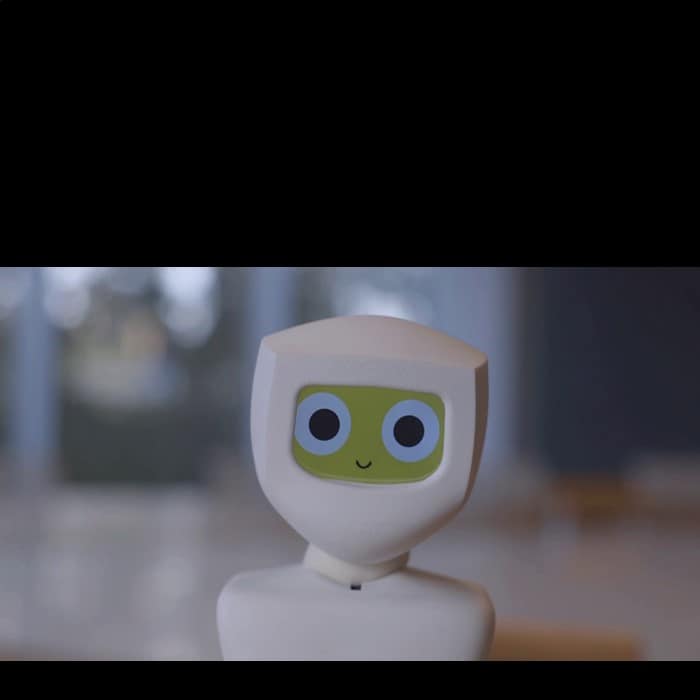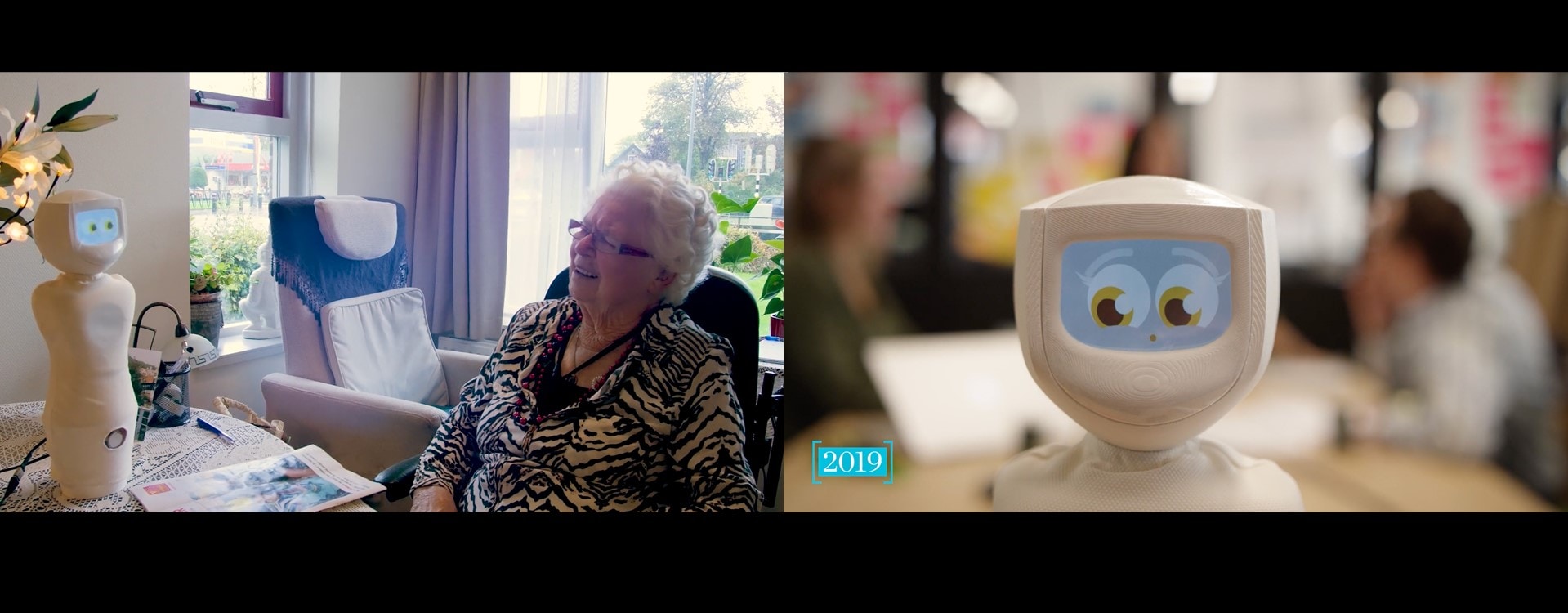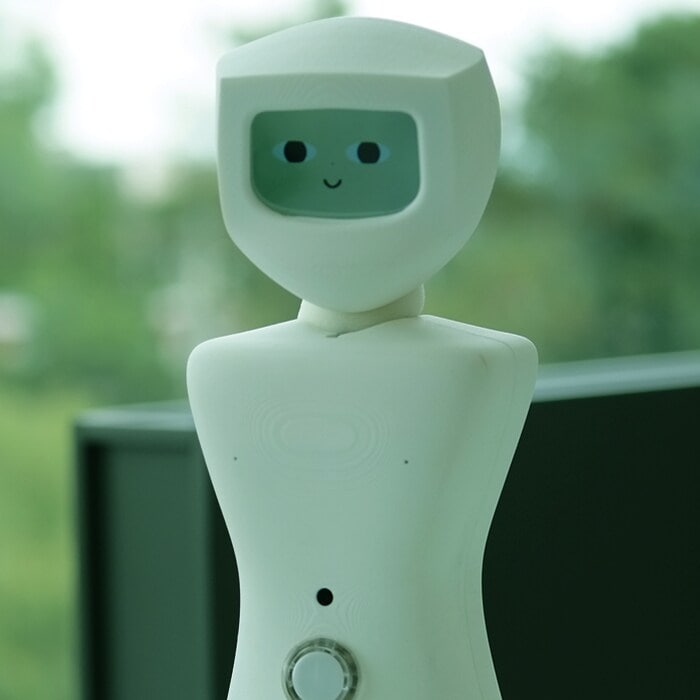Impact Stories by Deloitte Consulting
Alice the social robot
A helping hand for care takers and a buddy for elderly, supported by the Deloitte Impact Foundation
‘Alice the social robot’ is a project that has been running for a few years and is working on a social robot for the elderly segment. The development of this robot is the product of a collaboration between the VU and Deloitte. This initiative, supported by the Deloitte Impact Foundation aims to relieve loneliness and improve the quality of life of elderly.
In the coming ten years, the amount of vulnerable elderly people in the Netherlands is expected to increase with 25%. The majority of those elderly will experience a growing feeling of loneliness. Today, already 200.000 of them have said to feel lonely on a daily basis. Research shows that the feeling of loneliness can have great impact on physical and mental health.
The existing problem of loneliness has only increased in the times of COVID-19. Especially elder people residing in care homes are feeling these consequences. They are being secluded (even) further from their social relations and the possibilities of making contact are limited. Public transportation barely functions and children and grandchildren are not allowed to visit. Some elderly find it hard to cope with new technologies and can have a difficult time adjusting. Often they are dependent on an instruction manual or a care taker helping them. In these times elder people are valuing social contacts, whether they are human or not.
The arrival of social robots and virtual agents offers us possibilities. ‘Alice the social robot’ is a project that has been running for two years and is working on a social robot for the elderly segment. The development of this robot is the product of a collaboration between the VU and Deloitte. Together with the initiators, professors Johan Hoorn and Elly Konijn, a multidisciplinary team from Deloitte under direction of Franklin Heijnen and Marly Kiewik, has been working on developing and testing robot Alice.
Robot Alice
This Deloitte Impact Foundation initiative has the goal to relieve loneliness and improve the quality of life of elderly by being a helping hand for care takers and a buddy to the older adult. Robot Alice has been developed in co-creation with the elderly users to perfectly respond to the needs of this target group. Alice can provide support on a daily basis in multiple ways. For instance she can bring structure in the day of elderly by giving them reminders of their upcoming activities or phone to relatives and friends. Those are examples of functionalities that motivate elderly to take action, but Alice can also support in a more passive way. As a social entity she can serve as a ‘listener’ to the user and ask him/her personal questions. She also plays your favourite song when it gets too quiet in the house, tells you what the weather is going to be and reads the daily news.


Test phase
One of the principles of the Alice project is that she is developed together with our target audience. Anne-Louise Meijer works within Deloitte Consulting as project manager of the Alice project. Anne-Louise: ‘Within this project we work together with elderly, caretakers and informal caregivers. Their input is valuable and offers unexpected insights during the design process. One of our design guidelines is to “design for forgiveness” and that it is okay to not have a perfect product.
The Alice project is also a learning journey. In the beginning we mostly focused on the needs of the elderly and what their daily life looks like. Through focus groups and interviews we asked the elderly about their needs and which functionalities they would prefer in the robot. They were also given the possibility to help us with the design. We asked them to make a drawing of the robot and started to design the hardware of the robot together, using toy blocks. By using co-creation we were able to create an overview of the life of an elderly and made a new robot design that fits their needs and preferences.’
NPO Brandpunt created an episode about the realization of Robot Alice, watch the video here.
Survival period
With the new robot design and insights a test phase was set up, called the “Survival Pilot”. The ultimate goal was to let Alice survive at an elderly’s house for 24 hours. Alice was placed at an elderly’s home multiple times to observe her functionality.
Marijn Hagenaar, who has been in charge of the user tests, explains: ‘We also looked at how the elderly reacted towards her and if she was able to make an impact on their quality of life. One of the elements that we implemented is that Alice is personal. We did this personalization through the Alice app in which we notated the daily activities of the elderly, which Alice could remind them of during the day, and a few conversation topics with matching questions. For all sessions we recorded video and audio footage. The footage was then analyzed with a coding scheme after every session. Alice was also able to provide some data. For example, she gave sentiment scores to the elderly’s verbal responses. The results of the observations, coding scheme and Alice’s data were combined in a digital dashboard in which quantitative and qualitative data were combined. Overall, an amazing experiment that provided us with many new insights.’
Results
Results showed that the robot does not have to be extremely advanced, but that personalization is key. Asking personal questions and playing music that the elderly like, gives users the feeling of being understood and that Alice knows them. The background information of the elderly is provided by the informal caregiver and implemented in the Alice app. The responses to the personal questions were overall positive. The elderly were surprised about Alice’s knowledge of them. Comments of the elderly were: ‘How did she know that?!’ or to caregiver: ‘Did you tell her that?’. Also, music was much appreciated. Elderly got a smile on their face and they often started to sing along.
During the Survival Pilot we noticed that when the elderly spent more time with Alice, the level of acceptance increased and the elderly started to understand the relevance of the robot. One of the elderly said: ‘Alice does not gossip and she would never laugh when you take out your denture.’ Providing structure by using the daily reminders which originate from the daily schedule was successful. The schedule was up to date and the elderly executed the proposed activities.
We also learned more about the functionalities of Alice. It was noticed that the response time of the elderly was lower than we had in mind. We choose to let Alice listen “actively’’. This means that she is always able to acknowledge reactions or answer to questions and commands and give an answer. It is also important that Alice does not talk too fast and that she asks the user for their attention beforehand or is able to repeat things.
Another striking result is that the elderly do not want to be seen as someone that has to be taken care of, but that they also like to take care of others. This is one of the reasons why we chose to give Alice a personality of a six-year old girl. Alice is very cuddly which is, among other things, caused by her child-like voice, big animated eyes and small body. Elderly appreciated this and even wanted to knit clothes for her.
The future of Alice
Anne-Louise: ‘Next to the extensive testing of our ideas and results, we are currently building an ecosystem of partners. Together with the VU we are building a network of healthcare institutions, universities, schools and other interested people and we want to continue the conversation on the topic of social robotics and the role they can play in our daily lives. One of those initiatives is our collaboration with Project Zilver and the ANBO, the Dutch union for the elderly, to exchange our knowledge and implement our resources. We aim to create an open and innovative ecosystem where ideas, knowledge and design can be shared.’








